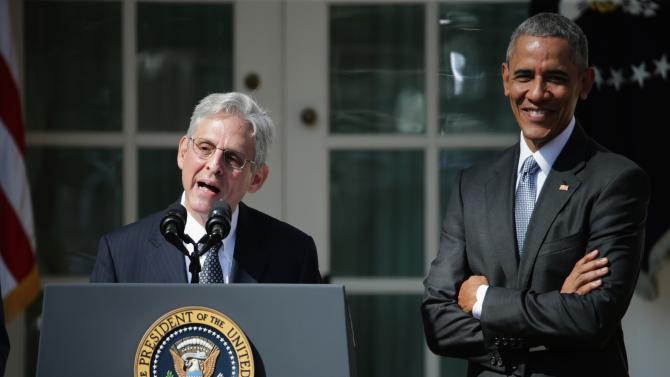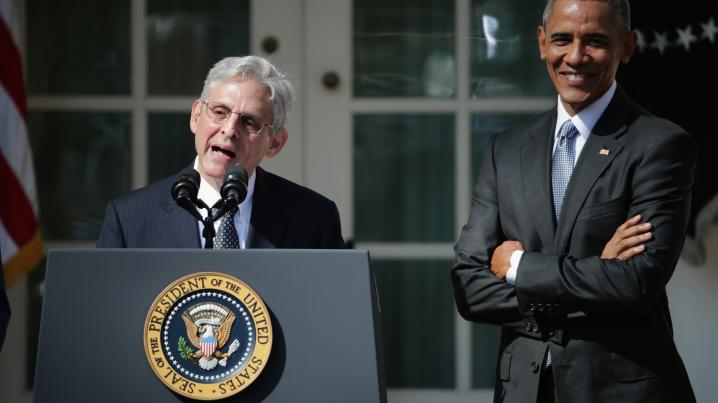[ad_1]

Judge Merrick B. Garland speaks after being nominated to the US Supreme Court as U.S. President Barack Obama looks on, in the Rose Garden at the White House, March 16, 2016 in Washington, DC. Garland currently serves as the chief judge on the United States Court of Appeals for the District of Columbia Circuit, and if confirmed by the US Senate, would replace Antonin Scalia who died suddenly last month.
Chip Somodevilla/Getty Images
Phones buzzed, feeds bubbled and the radio call-in lines lit up when President Obama announced his nominee for the Supreme Court: Merrick Garland. And if you later researched one of those few moments when black folks were universally vexed with their beloved first black president, this would be it: why on Earth did he NOT pick one of us?
This wasn’t the first time. Three times the White House skipped over highly qualified black applicants (although one of those choices was Latina Sonia Sotomayor). Don’t we have enough gray-haired white dudes running the Big Bench, Mr. President. No please, go right ahead, grace us with one more.
There was remote hope that he would finally pick someone other than white Ivy League law school chums (do state schools or Howard Law count anymore?). Civil rights leaders pleaded with the president to make his last pick diverse and historic (and preferably black). Some pitched tough for a black woman as a way to fire up black voters in November. When the presumptive black list of nominees grew thin – high profile Attorney General Loretta Lynch yanking herself out – some seemed resigned with short listed circuit court judge, and Indian American, Sri Srinivasan. So long as POTUS mixed up the Court’s complexion, all might be forgiven.
Moving on, it’s time to make sense of this thing. Let’s chew on five theories rationalizing the Merrick Garland pick:
The obvious: let’s embarrass Republicans … some more. The Grand Old Party is struggling with enough image problems as is, so enter the president with a good old fashioned rub-it-in. Since Republicans welded themselves to guarantees of obstruction, with Senate Majority Leader Mitch McConnell (R-KY) and others offering melodramatic “over my dead body” impressions, the White House gambles that opposition hypocrisy will do the trick. Senate Judiciary Committee member and conservative elder Sen. Orrin Hatch’s (R-UT) praise of Garland (not once, but) twice as a high court pick, even as early as last week, doesn’t help the misled cause. So what’s the difference between the President Clinton-nominated Garland of 1997, when Senate Republicans (also in the majority at the time) gave him a hearing and a 76-23 vote to the D.C. Circuit Court and the Garland of 2016 when President Obama nominates him to a bigger Court?
Loosely paraphrasing Kevin Hart: Gimme my Senate seat back mitches! Never underestimate the long-game grudges of a president who frequently prefers the use of armed drones and stealthy Special Forces teams to kill terrorists. It’s probably not a coincidence that Garland is a Chicago native – and, well, look at that: Illinois has a Senate. Of the many political humiliations President Obama had to endure, few stung as bad when Republican Mark Kirk snatched his old Senate seat in 2010 – after the embarrassing appointment of temporary placeholder Sen. Roland Burris (D-IL) by later convicted Gov. Rod Blagojevich (D-IL). Now running for a second term, Sen. Kirk (R-IL) must fend off a stiff challenge from disabled war veteran Rep. Tammy Duckworth (D-IL). Even if he’s moderate, not a good look for Kirk to represent the party that wants to keep a homeboy off the Bench. Last poll, while dated, showed Kirk six points behind Duckworth. No surprise if Kirk has to quietly beg his fellow GOP Senators to reconsider their stance. Revenge is a mitch, ain’t it!
Even Steven: You sink my SCOTUS nominee, I sink your Senate Majority. All this talk about the presidential race and little talk about the Senate races this year. Senate Republicans may appear solid on the surface with their 10-seat majority, but a look at the 2016 Senate map shows some cracks in the hull. Republicans are faced with four “toss-ups” compared to Democrats’ one. And four other seats that end in the “Likely” or “Lean” category – Arizona, Iowa, Missouri and North Carolina – each house GOP incumbents with low ratings according to Public Policy Polling poll on voter attitudes about the Supreme Court fight. In these states, voters aren’t feeling the Republican blockade; nationally, as YouGov shows, a clean majority of voters (53 percent) believe Obama should nominate someone to the Supreme Court.
Naturally, the president sees an opening where even if he doesn’t get his nominee approved, he’s gift-wrapped a Democratic Senate for the next Democratic President. The play is not so much about the nominee. It’s about giving his (presumed) Democratic successor a Congress they can work with.
Better the white guy as sacrificial lamb. On this one, Republicans (desperate for an anti-Obama battle cry this fall) seem hell bent on rejecting any nominee, even when they like him. For Garland, that’s ok: as an esteemed white judge, he’s propped better racially, professionally, optically and financially to weather the storm. It would’ve been uncertain for Lynch; in her legal prime as first black woman AG, a nomination cage match could have left her spent and tainted. Or, could 45-year old D.C. Circuit Court judge Ketanji Brown Jackson – favored by many black political leaders – have emerged unscathed from combat with hostile white Republican Senators in her business?
Let’s not alienate the white voters, please. While slim, a 48 percent majority of white voters told YouGov that President Obama should nominate a SCOTUS replacement versus 40 percent who didn’t. With 79 percent of black voters saying the same thing, the White House felt like it needn’t worry about any community blowback (“you’ll still love us in the morning, fam”). And a quick cost-benefit look from the president may have found that a nominee of color pitted against white Republican opposition on Capitol Hill wasn’t worth the hassle given the brewing national “race war” narrative permeating the election. That’s too much racial powder keg for one year.
Pushing the diverse nominee, while ideal, could have also come at the risk of Democrats losing white moderate and independent voters who aren’t all that aligned with multicultural policy priorities. This would’ve been equally problematic for more-than-likely Democratic standard bearer Hillary Clinton, fresh off a primary battle with Bernie Sanders over who was the “black-friendly” candidate. Now, she has to pivot to white voters (since, well, they are 70 percent of the total electorate). The Garland nomination just took the fight down a notch. And it’s not like she has to stick with him if she wins (and he hasn’t been confirmed). Theoretically, with her in the White House and Democrats running the Senate, it doesn’t get any better than a SCOTUS nominee confirmed in the first 100 days of your administration.
[ad_2]





















